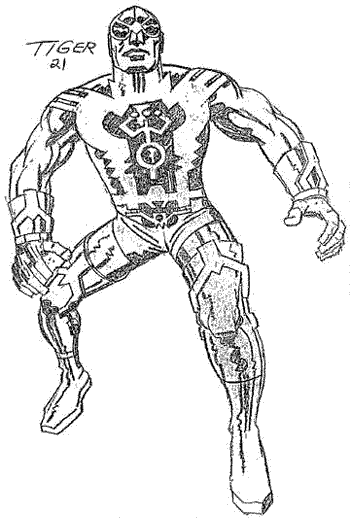|
|
The Unfilmed Ideas Of Jack Kirbyby & © Steve ShermanFrom Jack Kirby Collector #11I'm writing this while sitting in a basement underneath Stage 15 at Sony Pictures Studios (formerly MGM) puppeteering the controls of an alien creature. Above me is a giant set of the interior headquarters of MIB (which stands for Men in Black). Based on the comic book, Men in Black is a science fiction picture produced by Steven Spielberg and directed by Barry Sonnenfeld. It's a story about aliens and cataclysmic galactic wars. Somehow it seems appropriate considering this article is about Jack Kirby and Hollywood. One of Jack's not-so-secret wishes was to direct a movie. To Jack, his comic book works were basically blueprints for movies. While many of Jack's characters have been translated into animation, Jack specifically wrote three concepts which he hoped would be produced as live-action pictures. The first of these was a show entitled Tiger 21 and was developed in the early 1950s. It was a re-working of an idea Jack had in the late '40s for a comic strip called Starman Zero. Jack had been approached by an agent who had a deal with NBC. In the '50s, before the advent of videotape, much of the live programming on television was produced in New York. The show was a half-hour science fiction program about a young hero who drove a vehicle dubbed Tiger 21. The location was a secret base on the moon called Command D. Each week the hero would be involved in adventures involving aliens and (this being the '50s) Soviet spies. Also vying for a spot on the network was another program entitled Man In Space which starred William Lundigan, and was more or less a realistic show about astronauts on the moon. NBC decided to go with Man In Space as the producer of that show was, according to Jack, the brother-in-law of someone at NBC. Not one to let things go to waste, Jack was later to use elements of Tiger 21 in what eventually became Kamandi, The Last Boy on Earth.  We're unsure if this 1980s drawing of Tiger 21 is what Jack had in mind for his 1950s show, but we thought you'd like to see it anyway. He must have felt strongly about the character if he was still thinking of him 30 years later. In the early 1970s Jack again turned his attention to films. The first of two projects was entitled The Lightning Lady. This was a science-fiction picture about a small town that is invaded by a colony of aliens led by the Lightning Lady, a queen bee alien. Jack later turned this into the comic book Captain Victory and the Galactic Rangers, adding the Captain Victory characters to the plot. One of the most enjoyable things about working with Jack was the opportunity to be able to just sit and listen to him spin tales or reflect on "what if" situations. One evening, we were discussing the concept of miniaturized worlds - something along the lines of what later would be termed nanotechnology. It was from this premise that we began discussing what would become the basis for Silver Star - Superhero. Jack thought that it would make an exciting picture and we began working on it. On weekends we would discuss the plot and characters and then during the week I would write it up. Eventually we had a 40-page outline of the story. Later Jack used this plotline for the Silver Star comic book. Jack never threw anything away, and ideas and plots that couldn't be used immediately were saved and used later; not that they were written down in notebooks. Jack somehow managed to keep it organized in his head. One idea was a 13-episode series that involved UFOs. I had just finished reading the novel Rendezvous with Rama and was talking it over with Jack. The more we discussed it, an idea took shape about what would happen to ordinary people who became involved with UFOs. Within an hour, Jack had come up with an anthology show about UFOs. It was very dramatic in tone with comedic elements; very Twilight Zone-ish. Jack had 13 plot synopses in no time. Just to hear Jack describe the show, I was sold. Jack held the premise that not all aliens would be friendly. Each person who came in contact with them would come away with something different, and not all of it good. The show had a lot of great story elements, especially since it would have a different guest star each week meeting these great Kirby aliens. Jack never got around to using it, but it was amazing to me how these ideas would just flow through him. Even without the drawings, Jack could be a spellbinding storyteller. With the advancements being made in computer-generated graphics and digital technology, hopefully we will someday see Jack's vision translated into reality.  Sign up here to receive periodic updates about what's going on in the world of TwoMorrows Publishing. |